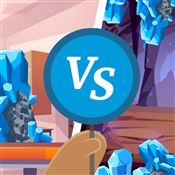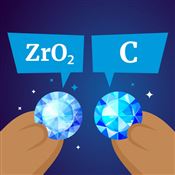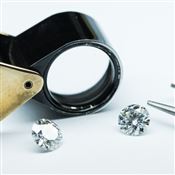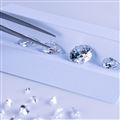Lab Diamond vs Cubic Zirconia
Lab diamonds and cubic zirconias are man-made gemstones. They look exactly like natural diamonds. But are they the same stones?
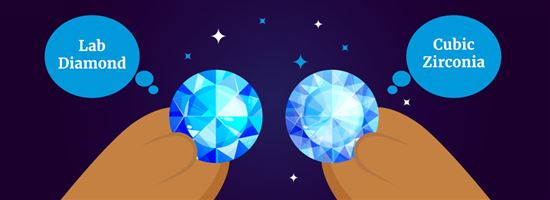 |
Scared of the deadly financial threat of natural diamonds?
Then lab diamonds and cubic zirconias might be for you. These man-made gemstones look exactly like natural diamonds. Plus, they don't break your bank account or destroy the environment.
But while they look the same, lab diamonds and cubic zirconias are two different gemstones.
Keep reading to learn the difference between lab diamonds and cubic zirconias. Compare appearance, durability, price, and more to know which gemstone is right for you.
Lab Diamond vs Cubic Zirconia Comparison
Before we go into detail, here's a quick comparison of lab diamonds and cubic zirconias:
- Lab diamonds are exactly identical to natural diamonds. From the carbon atoms to the sparkle, they're one and the same stone. The only difference is that lab diamonds are grown inside, well, a lab. They're perfect when you want a natural diamond at a way lower price.
- Cubic zirconias are easily mistaken for diamonds since they're both white and sparkly. But they're entirely different stones. Cubic zirconia is a good choice if you want a short-term stone that passes off as a diamond for a very cheap price.
| Lab diamond | Cubic zirconia |
|---|---|
| Man-made | Man-made |
| Made of carbon | Made of zirconium dioxide |
| Begins at around $1,000 for 1 carat | Usually retails below $50 for 1 carat |
| 10 on the hardness scale | 8.5 on the hardness scale |
| Range of color and clarity | Colorless and flawless |
| Lighter than cubic zirconias | Denser than lab diamonds |
| Gives off white sparkles | Gives off rainbow sparkles |
What is a Lab Diamond?
Lab diamonds are every bit the same—in terms of chemical and physical properties— as natural diamonds.
They're so identical that not even jewelers and gemologists can tell them apart. Plus, they pass diamond testers. The only way to find a difference between them is through specialized gem laboratories.
What sets them apart is lab diamonds are made inside a laboratory, not Mother Nature's chambers. It takes millions of years for the earth to make diamonds. But scientists can mimic this process in just weeks.
Considerable costs and energy go into the production of lab diamonds. But compared to mined diamonds, they're still 60%-70% cheaper and more eco-friendly to produce.
Choose a lab diamond if you:
- Want a diamond but for less cost
- Are not picky about the stone being man-made
- Want durability
- Want a grading report for your stone
What is a Cubic Zirconia?
Cubic zirconias are man-made diamond simulants. Because they're both white, they appear to "simulate" diamonds, including lab-grown. But they're two different gemstones. Diamonds are made of carbon, while cubic zirconias are made of zirconium dioxide.
Untrained eyes often mistake cubic zirconias for diamonds. But jewelers can identify cubic zirconia through several techniques. They won't pass diamond testers, either.
And while cubic zirconias are cheap to produce, durability is a major issue for this gemstone.
Choose a cubic zirconia if you:
- Want something that looks like a diamond for very cheap
- Plan to replace the stone in the future
- Want a stone you won't mind getting lost or worn down
Lab Diamond vs Cubic Zirconia Appearance
The average person may find it hard to distinguish lab diamonds from cubic zirconias. But due to visual differences, jewelers can tell them apart with their eyes.
Lab diamonds and cubic zirconia don't sparkle the same way. At 2.42, diamonds have a higher refractive index. Compared to cubic zirconia's 2.2. This means diamonds appear more dazzling because they reflect more light.
Cubic zirconias have a higher dispersion rate.
Remember how white light is a mixture of all colors? Cubic zirconias are faster at separating white light into its constituent colors. That's why cubic zirconias give off rainbow sparkles while diamonds shimmer in white lights.
Lab Diamond vs Cubic Zirconia Pricing
Lab diamonds cost 30% of the price of natural diamonds. But cubic zirconias can be purchased for as little as 0.30%.
We browsed through James Allen and found that their cheapest 1-carat natural diamond retails at $4,130*. Compare this to their 1-carat lab-created diamonds, which range from $1,410 to $3,000.
Meanwhile, loose cubic zirconia stones typically sell for under $20. You can even buy wholesale for as low as $4 each! For ready-to-wear cubic zirconia jewelry, silver rings cost around $50. If you opt for more premium metals, shops like Birkat Elyon sell 1-carat cubic zirconia rings in white gold for around $1,000.
*Prices as of May 21, 2022
Lab Diamond vs Cubic Zirconia Durability
While lab diamonds are forever, cubic zirconia lasts for a few years.
Both lab diamonds and their natural counterpart rank 10 on the Mohs hardness scale. As the hardest material on earth, it's a stone for a lifetime.
Cubic zirconias rate 8.5. They can withstand daily wear but can also chip when hit hard enough. Anything higher on the Mohs scale, like emery boards and scratch-proof glass, can scratch this gemstone.
As a result, cubic zirconia can get cloudy from these scratches. You may need to replace your stone after a few years.
Lab Diamond vs Cubic Zirconia Color And Clarity
Like natural diamonds, the color of lab diamonds is graded on a scale of D (colorless) to Z (light yellow or brown). The whiter a diamond looks, the more expensive it is.
Cubic zirconia is always manufactured colorless. Most already look like the highly coveted D-colored diamonds. So color isn't a problem with these stones.
Lab diamonds also differ in clarity due to blemishes. Whether below the earth or inside a lab, natural imperfections form during diamond production.
Meanwhile, cubic zirconias are almost always flawless. No need to look out for visible imperfections as opposed to diamonds.
Lab Diamond vs Cubic Zirconia Carat Size
Cubic zirconia is denser than lab diamonds.
Between cubic zirconia and a lab diamond of the same carat, cubic zirconia should be slightly smaller in physical size. Weighing the stones is one way that jewelers tell cubic zirconia from a lab diamond.
Lab Diamond vs Cubic Zirconia Resale Value
Lab diamonds and cubic zirconia are worth nothing after purchase.
Some jewelers claim that there's a resale market for lab diamonds. But most still agree that lab diamonds lose value the moment you buy them. Because they're mass-produced, lab diamonds don't hold value for being rare.
When comparing long-term benefits of lab diamonds and cubic zirconia, you should keep durability in mind. Not the resale value.
Lab Diamond vs Cubic Zirconia Ethics
Want to make more ethical jewelry choices? A lab diamond or cubic zirconia might be for you.
Both gemstones are conflict-free and eco-friendly alternatives to natural diamonds. Inside labs, they're free from the destructive and unethical practices of mining.
But they still emit greenhouse gasses during production. And with cubic zirconias, replacing your stone often cancels out the lower eco-footprint. So in the long run, lab diamonds may be the more sustainable choice.
Bottom Line
Lab diamonds and cubic zirconias are entirely different stones. But both can be good alternatives to natural diamonds, depending on what you're looking for:
- Lab diamonds are perfect if you want a more affordable and ethical real diamond. If you don't mind the zero resale value.
- Cubic zirconias are perfect if you want a cheap but temporary diamond-passing stone. It's also the perfect option if you're uncomfortable with wearing expensive jewelry.
Getting a stone that doesn't fit your needs can surprise you in unwanted ways. So be sure to do thorough research first before deciding if a lab diamond or cubic zirconia is best for you.
Write to Chesca Santiago at feedback@creditdonkey.com. Follow us on Twitter and Facebook for our latest posts.
|
|
|
